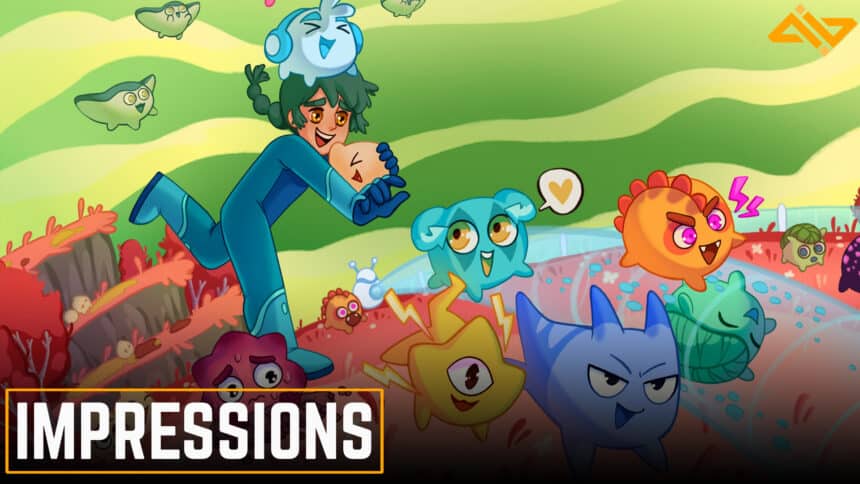Jumping into Time To Morp felt like opening a book to a world vibrant with color and life. This game, with its cozy ambiance and engaging gameplay, promises a unique experience that blends the charm of creature collecting with the depth of resource management.
Here are my first impressions of Time To Morp, navigating the challenges of automation and taking care of these adorable creatures on a procedurally generated distant planet.
Graphics

The art style of Time To Morp is a breath of fresh air. Its vibrant, colorful world is eye-candy, reminiscent of No Man’s Sky but with the playful charm of Spore. The game’s developers chose a cartoonish style that perfectly captures the essence of coziness, steering clear of hyper-realism.
This art direction enhances the game’s appeal, creating a world that’s both inviting and intriguing. Overall, it makes exploration and interaction a constant joy. At times though it can feel overly stimulating to the point when you forget what to do next.
Story

Embarking on Time To Morp‘s journey, you play as an intern in a space expedition gone wrong. Stranded on an unknown planet with your crew, the game quickly introduces its central loop: discovering and nurturing creatures scattered around the world called Morps.
Time to Morp focuses more on exploring and automating resource gathering with a sense of purpose. While the storyline might not break new ground, it provides enough context to make each discovery and achievement feel significant.
Gameplay
Here lies the heart of Time To Morp – its gameplay. Catching Morps and assigning them to areas while optimizing resource production felt like dabbling in a simplified, yet profoundly engaging version of Factorio.

There were moments when the world seemed too vast, leaving me wondering about my next move. Yet, these instances of uncertainty were balanced with a comprehensive technology tree that got me hooked deeper into the game’s mechanics.

And for those who dread reading through tutorials, Time To Morp offers intuitive tips and guidance, although the game is equally rewarding for players who prefer to explore and learn on their own.
I just wish that it was easier to mark certain locations in the compass instead of just knowing where your crew is on the map. Although the game has a scanner where you can look for specific resources, you tend to get lost on which part of the map you built a base for your Morps.
Building, Evolution & Tech Trees
The challenge of creating suitable habitats for Morps and the intriguing evolution mechanic add layers of strategy to the game. The requirement to feed Morps specific resources to trigger their evolution introduces a puzzle-like element to creature care, reminiscent of a minimalist Pokémon experience.

However, terraforming some areas felt janky as I was trying to create some leveled terrain so that it would be easier for me to explore the rest of the planet.

On the bright side, I like how they implemented the tech tree upgrades here and I can compare this to Factorio. While Factorio had a more complex way of progressing through the research where you had to feed your research points into a lab, in Time To Morp, as long as you already have the required materials, you can just upgrade right away.
Quests and Crew Relationships

The game attempts to weave a social fabric with side quests and crew interactions, rewarding players with bonuses like expanded inventory slots done through researching the tech tree. However, these elements felt somewhat underdeveloped, lacking the depth of connection seen in titles like Harvest Moon or Stardew Valley.

Most quests revolved around basic fetch or craft tasks, which, while diversifying gameplay, didn’t significantly enhance the narrative or emotional investment. However, I love that Time To Morp also doesn’t force you to complete quests. You can just simply enjoy the environment and take your time thinking of what you want to research or optimize next.
The Verdict

Concluding my Time To Morp first impressions, the game presents unique challenges in the automation and creature care genres, striking a balance between simplicity and strategic depth. The game’s visual appeal, combined with its unique gameplay mechanics, offers an engaging experience.
Combat is notably absent, emphasizing resource management and exploration over battle. This might deter those looking for a more action-packed experience, but for me, it underscored the game’s unique appeal.
Despite the resource gathering being a heavy grind in the later hours of the game, you will still get that challenge in trying to optimize your base during your stay on the planet. Overall, it’s a cute and cozy automation game, enough to get you playing for the whole day.
Time to Morp on Steam
Like our first impressions so far? You can now on Steam at a 20% discount, available for two weeks ($15.99 / £13.40 / €15.60), returning to its base price of $19.99 / £16.75 / €19.50 following this period.
If you also want to learn about the creative process that brought this game to life, read through my interview with the team behind Time To Morp.
This preview is based on the PC version of Time to Morp. The key was provided by Yogscast Games.










